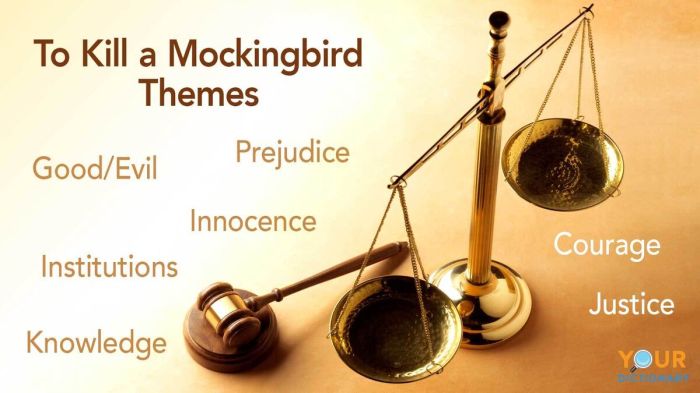Literary elements for to kill a mockingbird – To Kill a Mockingbird, a seminal work by Harper Lee, offers a rich tapestry of literary elements that captivate readers and delve into profound themes of justice, prejudice, and morality. This exploration unveils the intricate web of characters, setting, plot, point of view, symbolism, themes, and style that coalesce to create a masterpiece of American literature.
Through the lens of these literary elements, we embark on a journey to uncover the novel’s profound insights and enduring impact.
Characterization

The novel features a diverse cast of characters who undergo significant development throughout the story. The protagonist, Scout Finch, is a young girl who narrates the story and serves as a symbol of innocence and hope. Her father, Atticus Finch, is a respected lawyer who represents Tom Robinson, a black man falsely accused of rape.
Tom Robinson is a tragic figure who embodies the racism and injustice prevalent in the South during the 1930s. Other important characters include Jem Finch, Scout’s older brother, and Boo Radley, a mysterious and misunderstood neighbor.
Development of Characters
As the story progresses, the characters grow and change in response to the events they experience. Scout learns about the complexities of race and social inequality, while Atticus demonstrates the importance of courage and compassion. Tom Robinson’s tragic fate exposes the deep-seated racism in Maycomb County, while Boo Radley’s kindness and empathy challenge society’s preconceptions.
Symbolism and Foreshadowing, Literary elements for to kill a mockingbird
The novel uses symbolism and foreshadowing to enhance the characterization. The mockingbird symbolizes innocence and the importance of protecting the weak. The presence of the Radley house and the rumors surrounding Boo foreshadow the novel’s exploration of the themes of prejudice and isolation.
Setting

The novel is set in the fictional town of Maycomb, Alabama, during the 1930s. The physical setting of the novel is described in vivid detail, with the heat, dust, and poverty of the South vividly portrayed. The social setting is equally important, as the novel explores the racial tensions and social inequality that were prevalent in the South at the time.
Impact of Setting
The setting of the novel has a profound impact on the characters and the plot. The heat and poverty of Maycomb create a sense of isolation and stagnation, while the racial tensions and social inequality provide a backdrop for the novel’s exploration of justice and prejudice.
Imagery and Symbolism
The novel uses imagery and symbolism to enhance the setting. The recurring image of the mockingbird symbolizes the innocence and vulnerability of the characters, while the Radley house represents the secrets and prejudices that lurk beneath the surface of Maycomb society.
User Queries: Literary Elements For To Kill A Mockingbird
What is the significance of the mockingbird symbol in the novel?
The mockingbird represents innocence, vulnerability, and the senseless destruction of life. It serves as a poignant reminder of the fragility of justice and the tragic consequences of prejudice.
How does the setting of Maycomb, Alabama, shape the story?
Maycomb’s small-town atmosphere fosters a sense of isolation and intensifies the impact of social injustice. The town’s rigid social hierarchy and ingrained racism create a suffocating environment that both protects and imprisons its inhabitants.
What is the role of Scout Finch as the narrator?
Scout’s perspective as a young girl provides a unique and often naive lens through which the events of the novel are filtered. Her innocence and curiosity allow readers to witness the unfolding drama with a sense of wonder and moral clarity.